

Let's first take a look at the effect that a has in
![]() while we let b and c
remain constant. We will let b and c equal 1 and
we will set a=-3,-2,-1,1,2,3 and overlay the graphs. The
following picture is obtained.
while we let b and c
remain constant. We will let b and c equal 1 and
we will set a=-3,-2,-1,1,2,3 and overlay the graphs. The
following picture is obtained.
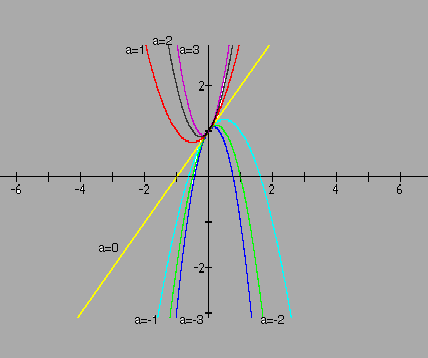
Notice a couple of things. First all of the graphs are going through the point (0,1). Next, when the value of a is zero, then the equation is no longer a quadratic equation. When a=0, the equation reduces to a linear equation. This is shown by the yellow graph above.
For a dynamic presentation of the effects of the a value
in the parabola above click here.
Graphs in the xa plane.
Consider the equation![]() and the graph of this relation in the xa plane.
and the graph of this relation in the xa plane.


Now let's take a look at the effects of the b value
in the equation ![]() while we let a
and c remain constant. We will let a and c
equal 1 and we will let b= -3 ,-2 ,-1, 0, 1, 2, 3.
while we let a
and c remain constant. We will let a and c
equal 1 and we will let b= -3 ,-2 ,-1, 0, 1, 2, 3.
So, if we set ![]() for b = -3, -2, -1,
0, 1, 2, 3, and overlay the
for b = -3, -2, -1,
0, 1, 2, 3, and overlay the
graphs, the following picture is obtained.
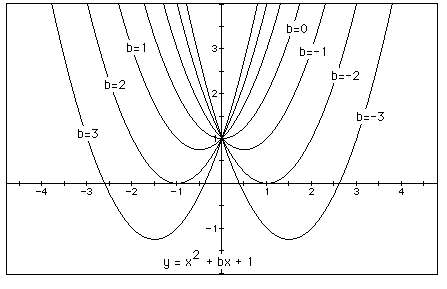
For a dynamic presentation of the effects of the b values in the parabola above click here.
We can discuss the "movement" of a parabola as b
is changed. The parabola always passes through the same point
on the y-axis ( the point (0,1) with this equation). For b <
-2 the parabola will intersect the x-axis in two points with positive
x values (i.e. the original equation will have two real roots,
both positive). For b = -2, the parabola is tangent to the x-axis
and so the original equation has one real and positive root at
the point of tangency. For -2 < b < 2, the parabola does
not intersect the x-axis -- the original equation has no real
roots. Similarly for b = 2 the parabola is tangent to the x-axis
(one real negative root) and for b > 2, the parabola intersets
the x-axis twice to show two negative real roots for each b.
Now consider the locus of the vertices of the set of parabolas
graphed from
Show that the locus is the parabola
Generalize.
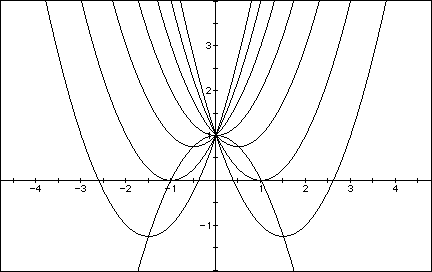
Consider again the equation ![]()
Now graph this relation in the xb plane. We get the following
graph.

If we take any particular value of b, say b = 3, and overlay this equation on the graph we add a line parallel to the x-axis. If it intersects the curve in the xb plane the intersection points correspond to the roots of the original equation for that value of b. We have the following graph.
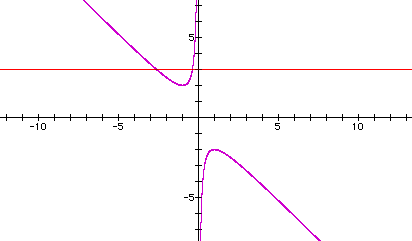
For each value of b we select, we get a horizontal line. It is clear on a single graph that we get two negative real roots of the original equation when b > 2, one negative real root when b = 2, no real roots for -2 < b < 2, One positive real root when b = -2, and two positive real roots when b < -2.

Finally, let's take a look at the effect the c value
has in the equation ![]() for c = -3, -2,
-1, 0, 1, 2, 3. We will let a and b remain constant
with a value of 1. Overlaying the graphs for the different c
values, we obtain the following figure:
for c = -3, -2,
-1, 0, 1, 2, 3. We will let a and b remain constant
with a value of 1. Overlaying the graphs for the different c
values, we obtain the following figure:
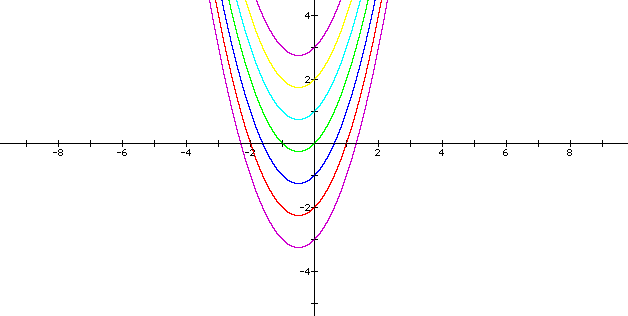
For a dynamic presentation of the effects of the c values in the graph above click here.
Let's consider the equation ![]() .
.
If the equation is graphed in the xc plane, it is easy to see
that the curve will be a parabola. For each value of c considered,
its graph will be a line crossing the parabola in 0, 1, or 2 points
-- the intersections being at the roots of the orignal equation
at that value of c. In the graph, the graph of c = 1 and c=-2
are shown. The equation
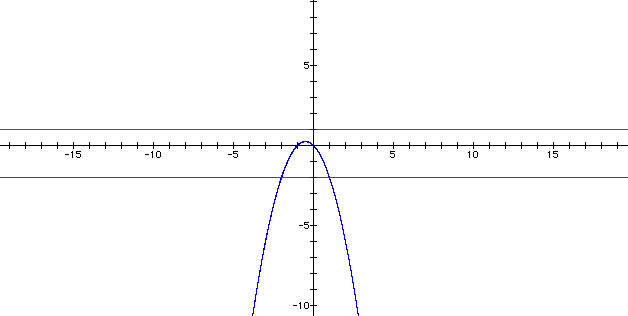
There is one value of c where the equation will have only 1
real root -- at c = .25. For c > .25 the equation
will have no real roots and for c < .25 the equation
will have two roots, both negative for 0 < c < .25,
one negative and one 0 when c = 0 and one negative and one positive
when c < 0.